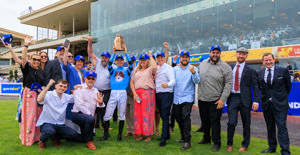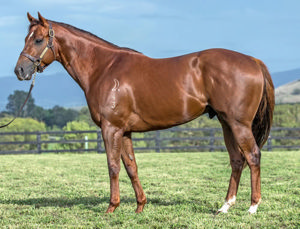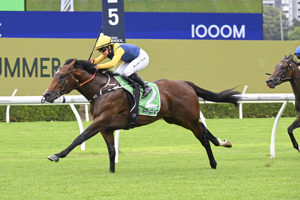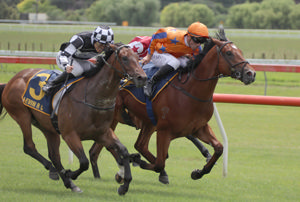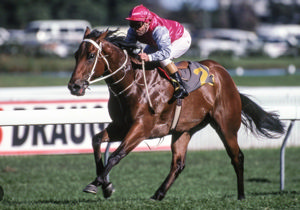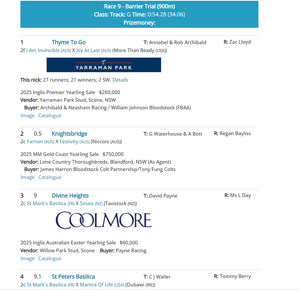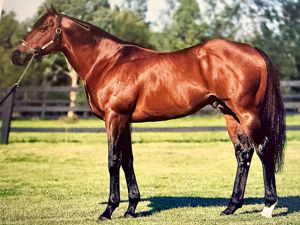 Stallion owners need the support of smaller breeders, many of whom are responsible for producing top class performers, to fill the books of their sires, so the present situation is of concern to Thoroughbred Breeders Australia, TBNSW, racing administrators, sales companies, owners, trainers and all concerned with the future of our industry.
Stallion owners need the support of smaller breeders, many of whom are responsible for producing top class performers, to fill the books of their sires, so the present situation is of concern to Thoroughbred Breeders Australia, TBNSW, racing administrators, sales companies, owners, trainers and all concerned with the future of our industry.
Caroline Searcy recently questioned a number of smaller breeders, all members of TBNSW, about their involvement, the problems they face and what they see in the future.
QUESTIONS:
Tell us about your breeding operation. Is it a hobby or a business. Do you breed horses for commercial purposes or to race yourself, or a combination of both?
ANSWERS
KATE NIVISON (Etak Thoroughbreds): Both, predominately commercial.
MIKE O'DONNELL (Fairhill Farm): Business. I breed for sale and race what's left.
FRANCIS COOK: My Breeding operation Awder Pty Ltd at Mystery Downs Trust is a business operation. I breed for sale predominantly at the Magic Millions, Inglis Classic Sale and Easter 2, as this is the level of my mares. If passed in then I endeavour to lease the horses to either friends or clients of various stables, retaining 30 % to 50% of the lease. I lease at 20% of gross as I feel that is fair.
The purpose is to improve the value of my breeding stock should the progeny be successful at least at city level.
CAROLE RICHARDS: I run it as a business.
STEPHEN RYAN: I started our breeding operation about eight years ago with the focus to be a commercial complement to our family training stable in Bathurst. Ideally we sell all yearlings but as is often the case some horses don't sell and we then race them. We also like to buy a yearling filly each year to later breed from if her temperament, soundness and ability warrant retention.
Where do you get your breeding stock? Are you agisting clients' horses or is the majority of your stock from sales or off the track?
KATE NIVISON: I agist all my horses. They are agisted with Tone and Jilly Henry, some are with Emirates Park Stud and one mare lives at Coolmore. Some are homebreds, fillies I couldn't sell and I retained, others I inherited. Some were bought as yearlings to become broodies. The majority were purchased in foal at the sales.
MIKE O'DONNELL: Breeding stock comes from sales and private purchases. We agist clients' mares as well.
FRANCIS COOK: Combination thereof. If a mare has been a city winner then I may retain and breed from her. I also try to turn over two or three mares a year and replace with mares from Inglis Easter in foal.
CAROLE RICHARDS: The intention is always to sell but sometimes we have to keep and race
STEPHEN RYAN: We have purchased mainly from yearling sales but also privately through agents and at broodmare sales. Whilst we have our own farm in Bathurst we keep our mares and foals at either Bellerive or Sledmere where expert care is taken of them.
What is your biggest success, of the horses you have bred?
KATE NIVISON: To date, Group 3 placed Lohan, who got to a Golden Slipper, from an old family of my dad's and grandfather's that I inherited. She was from my first crop of "commercial" breeding.
MIKE O'DONNELL: $700,000 sale.
FRANCIS COOK: Calaluna - winner of five city midweek races, Kyros - stakes placed at two, So So Sure- won six, placed eight.
CAROLE RICHARDS: I have not bred a stakes-winner or stakes-placed horse but some have competed in stakes-class.I have bred a few city winners, one with $200,000 prize money. I buy yearling fillies and race, then breed.I keep my breeding stock at Widden Stud.
STEPHEN RYAN: Best sales success was at Melbourne Premier, $200,000 for a Danzero filly whilst our best race horse is So Genourous (nine wins including two in the city) and his half-brother Our Canny Boy(six wins, two seconds in eight starts ) which we raced and trained.
Have you found costs are prohibitive for some broodmare owners and they are deciding to either cull their mares or not breed them some years?
KATE NIVISON: Yes, vet fees and stallion fees are now prohibitive. Also agistment costs are rising and training fees and all the add-ons are now too high.
MIKE O'DONNELL: At least six clients who were breeding four years ago, no longer breed.
FRANCIS COOK: I will be substantially reducing my 13 mares down to about three or four and eventually revert to "hobby status", as sale prices do not justify the service fees for most of my stock. I may have a $70,000 or $80,000 sale but then two don't get accepted, two are passed in and another one or two don't reach reserve, so meeting the Tax Office's requirement to be "profitable" has become exceedingly difficult.
CAROLE RICHARDS: I have already decided to get out. My mares are not "silk department" and unless you have stakes-winners or stakes-producers it is just not worth it. You cannot get your breeding costs back unless you are lucky enough to get an outstanding type
STEPHEN RYAN: I have tried to only keep what I think are mares who have a reasonable prospect to produce good commercial foals that can make the Easter or Premier sales. I tend to think costs are reasonable if you consider the value of infrastructure of the agistment farm and staff costs for good horse management. The bigger issue is the misfortune if you lose a top mare or foal or are beset with a run of bad conformation/x-ray issues. So it's not the costs that so concern but the hand nature can take. I never insured livestock until recently. This proved a very expensive lesson losing a Group 1 - winning mare (cost $260,000) and a few months later a beautiful weanling from a Group 1 - placed mare, both in freak paddock accidents.
Are stallion fees too high? There are a range of value stallions available, but is even a $10,000 or $20,000 fee too high to give a mare owner a commercial return?
A
KATE NIVISON: Yes, one bad-legged or backward foal and you are in trouble.
MIKE O'DONNELL Stallion fees are too high. Sales prices tell you that. Look at how many, cover costs. $10,000 to $20,000 service fees make it possible to make a profit, but only if one is running a few mares. The owner with one or two mares would find it difficult.
FRANCIS COOK: I operate in the $10,000 to $25,000 range. I try to pick the stallions I think are well priced and likely to be commercial in three years time. For instance, Encosta De Lago at $12,000, Not a Single Doubt at $12,500, Northern Meteor at $20,000, they were good value at the time.If you are paying $20,000 then you need to sell for $60,000 and that is sometimes hard. Of course a lot of pedigree analysis has been done first so finding a good match that is commercial is a challenge too.
CAROLE RICHARDS: See above. It costs just as much to get a yearling to sale from middle level stock as it does for the top end. You only have to look at the median and average for the Sydney Classic Sale to know that more than half the yearlings sold are being sold at a loss at that sale.
STEPHEN RYAN: I think there are several horses whose fee is set way too high. But the market place has a wonderful ability to correct such situations. Many high profile stallions come to mind in recent years. But breeders don't need to support stallions at ridiculous fees.
You can't make money paying outlandish service fees but if you choose a stallion at the right time, sound commercial returns can be enjoyed. For example, I have used Snitzel at fees in the low $20,000's, also at $35,000 and this year at $45,000.The only yearling from those services sold for $150,000 off a $22,000 fee, one is a foal and the other a current pregnancy.
More Than Ready was a good prospect even after his results were proven and up to about $40,000 he could be very profitable. I have found that most farms are very negotiable. This year I used a top stallion advertised over $70,000 at circa $40,000 and I am confident of a solid commercial return.
I think the quality of mare is the greatest problem, not the service fee. An attractive mare with a metropolitan winning record and pedigree that appeals to trainers can be quite profitable even if not a black type winner.
How much does it cost you to prepare a horse from conception to yearling age? (ie cost of mare, her agistment, feed and care, vet-work, foal-watch, foaling down, weanling and yearling handling etc)
KATE NIVISON: I haven't done the costs for this year yet but I don't think I would get much change from $20,000. It depends on the sales and particularly the vet costs for the season and whether I sell them as weanlings or yearlings, also what sale etc.
MIKE O'DONNELL: Last time I costed, it was $25,000 without sales commission, entry fee or depreciation of the mare.
FRANCIS COOK: As I pay agistment the cost would be around $20,000
CAROLE RICHARDS: Mare $13,000 per annum. Foal $5,000 per annum. Yearling to prep and sale $16, so a total of $34,000.
STEPHEN RYAN: I budget on $11,000 per annum each mare and 16 months at approximately $15,000 post weaning for a foal, including sale prep. The mare's value needs to be amortised over say eight years depending on her age. I also now add 3% of the mare/foal value for insurance cover.
I budget on contingencies including veterinary, stud book, marketing and sale nominations $7,500, selling commission 10% (farm and sales company combined) and transport $1000.
I have recently purchased a mare for $80,000 and mated her to a top stallion for $40,000. I am hopeful of a sales yearling of around $120,000, which should give a $30,000 profit. One obviously hopes for an occasional big sale that will cover the bad conformation, barren mare etc. Hopefully I have chosen the right mare and stallion and my expectation on the yearling value is conservative. If I am incorrect, then as in any business, I will be punished.
I think this highlights the issue. The collective of costs are the same whether your mare is inferior or not, so the important thing is mare selection and not over-mating her otherwise you will go broke.
What do you find the most difficult issues confronting small breeders in NSW currently?
KATE NIVISON: The cost of stallions and the fact it is hard to get "deals" with the studs as a smaller breeder. Also the vet costs in the Hunter Valley are a nightmare even if you are on a contract.
MIKE O'DONNELL: Making a profit.
FRANCIS COOK: The underlying pressure of the Tax Office potentially disallowing either or both GST retrospectively and prior tax losses, whilst trying to establish a profitable business, despite best endeavours, too much worry.
CAROLE RICHARDS: Unless you have top quality mares forget it. The best mares are highly sought-after and very expensive and unaffordable for most small players. There is now a very long tail in both the mare and yearling markets and virtually no middle market because trainers are not speculating any more and syndicators are super fussy. It is a different world from when I started 20 years ago when anyone could have a crack.Now you need to have plenty of funds.The change in government policy re tax loss refunds did not help.That provided the cash flow for my business in bad years.I have had to inject personal funds and that cannot continue now I am no longer working full time.
STEPHEN RYAN: Buying good mares or yearling fillies that are worth breeding from - they are like hens teeth! If you can get good metro class mares or fillies with sound pedigrees that can win races and engage expert management (and some luck) then I think the environment for breeders with prize money and BOBS incentives has never been better.
Another challenge has been the high Australian dollar, which I suspect has dampened overseas demand.
Another industry issue is the demise of the staying pool with our concentration on sprinters. However, I am hopeful that the economics of racing stayers with BOBS Extra and the significant prize money in staying events will encourage the breeder to invest in the appropriate mares and stallions to correct the trend. However, you must be careful as an individual trying to reverse the stayer trend because you can go broke selling stayer yearlings in Australia.
Do you have suggestions of ways to make the major problems easier for small breeders?
KATE NIVISON: I don't think the issues facing smaller breeders are different from the bigger breeders who don't have stallions, it is just that with more mares you have the opportunity to cover costs over a wider scope. The biggest issue isthe stallion fees but also selling yearlings now is just as big a cost which is why I am now selling mine as weanlings. I think if you can't prep your own horses it is really hard to make money with sales costs and the commissions the farms take now.
Rumours of a few agents and trainers acting unethically at sales is a concerning issue. Time and time again you see new people walk into our industry and get taken for a ride, whether it is through what they buy to start with or some agents not disclosing commissions they receive when they book a mare into a stallion.
FRANCIS COOK: Unfortunately I think the market will have to take care of small breeders or just surrender GST status and breed to race as a hobby. At my size I either have to invest $1 million to get two or three more black type mares, or downsize to hobby status, unless I have a great sale this year, which is what we all aspire to!
CAROLE RICHARDS: I am afraid not. Unless you are a cashed up boutique breeder you are on the outer.
STEPHEN RYAN: I think the racing and breeding industry face challenging times developing and retaining horsemanship skills that leave for higher income returns elsewhere. This is a major issue for rural Australia, not just breeders.
I think the place of the smaller privateer standing stallions needs to be encouraged to foster a broader market offering. In this regard it was great to see Newhaven and Bowness standing top horses in the last season.
However the major farms do offer a choice of stallions the envy of most breeding nations, so I think we need to be careful being too critical of the stallion farms.
Is there anything you think Thoroughbred Breeders NSW could help with for small breeders?
KATE NIVISON: Honestly I don't think so and many of my family and friends are getting out of the industry.
MIKE O'DONNELL: Negotiate a more reasonable service contract for breeders. Free return is ridiculous in this day and age. So is an obligation to pay for a service fee if the mare slips after the 45 days.
FRANCIS COOK:
(a) The current proposal from Racing NSW to force owners registering a horse to provide either credit card details or a direct debit on their bank account, to allow RISA to police training fees if not paid in 30 days, will be a major disincentive particularly in getting first time owners into racing. If we can't get owners then the demand for horses at sales will decrease, particularly from the middle market. In my case, passed-in horses will be difficult to lease, in fact why would I bother, as the proposal makes the lessor liable for all debts as the card details have to be supplied at registration. The lessor has to register the horse before leasing ipso facto, TBNSW should look into this as it will be a disincentive to both breeders and buyers.
PS: I will be a seller, not a buyer at the yearling sales this year.
(b) Prizemoney needs to be increased down the line, not by doubling Group One races as this benefits only a few and more than ever will benefit the buyers of overseas middle distance and staying horses.
( c ) Lobby for more races for fillies and mares in spring and autumn outside Group races. Many stay at home not earning, as there are no races. The less middle-market races, the less middle-market buyers.
CAROLE RICHARDS: Not really unless you can get the government to reverse their tax rulings, unlikely in the current climate.
STEPHEN RYAN: I think the value of TBNSW is that it harnesses a collective voice, which is essential when dealing with policy makers, researchers, the ATO etc.
Do you insure your horses?
KATE NIVISON: Yes
MIKE O'DONNELL: We have too many. We are running 25 mares and I find it better to insure one's own.
FRANCIS COOK: Not the broodmares unless they are in foal to a stallion such as Northern Meteor.
CAROLE RICHARDS: Yes.
STEPHEN RYAN: I do now!
Some of the big farms in particular, and indeed some other farms, do offer deals and are open to negotiation on stallion fees and other charges. Are you aware of that and do you know who to approach and how it can work?
KATE NIVISON: As I said earlier, it is very hard to get the deals without the numbers, and as a woman many of the men in our
industry can't seem to talk to women, they are very "menzitie." I think it is harder as a woman in the industry.
MIKE O'DONNELL: Yes.
FRANCIS COOK: Yes, aware of these but usually it is because the stallion is not popular thus you take a bigger risk that it will also be unpopular by sale time, even if you produce a good foal/yearling.
CAROLE RICHARDS: Yes.I have used foal-share and lease deals in the past.
STEPHEN RYAN: I always call and discuss fees with the nominations managers and try to get the best terms. The farms are almost always reasonable as they desire a good long-term relationship. I think it is important to develop a good association with key people on the farms. Treat them as partners in the exercise of breeding rather than as the opposition, which I often think broodmare owners do.
What keeps you involved in the industry as a small breeder? Is it a passion or is it still a viable business?
KATE NIVISON: It is a passion but it is a business, I have set goals and
if I don't reach those I will walk away.
MIKE O'DONNELL: It's a passion.
FRANCIS COOK: Passionate horse lover aspiring to be profitable !
CAROLE RICHARDS: Getting out – see above. It is a passion I can no longer afford.
Do you think you will still be breeding horses in ten years?
KATE NIVISON: I honestly hope so, but realistically I doubt it, especially if Racing NSW brings in the registration of owners which is another cost that will be farmed off to the smaller players. I think the industry needs to realise that realistically most breeders are owners, as you can't always sell your stock. Until the bigger players realise that small breeders are an integral part of the industry, the way the industry is going I don't think smaller breeders can exist. I have seen many of my family and friends walk away and unless something changes I may join them.
MIKE O'DONNELL: Yes.
FRANCIS COOK: Doubt it.
CAROLE RICHARDS: No, sadly.
STEPHEN RYAN: Definitely - God willing.
FOOTNOTE – If you would like to express your opinions on any of the matters raised or have ideas on how we can improve the viability of smaller breeders please email media@breednet.com.au

